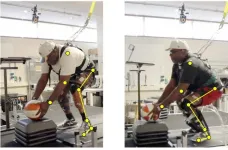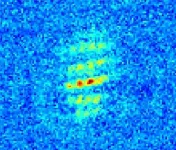(Press-News.org) A recent case study from North Carolina State University and the University of North Carolina at Chapel Hill demonstrates that, with training, neural control of a powered prosthetic ankle can restore a wide range of abilities, including standing on very challenging surfaces and squatting. The researchers are currently working with a larger group of study participants to see how broadly applicable the findings may be.
"This case study shows that it is possible to use these neural control technologies, in which devices respond to electrical signals from a patient's muscles, to help patients using robotic prosthetic ankles move more naturally and intuitively," says Helen Huang, corresponding author of the study. Huang is the Jackson Family Distinguished Professor in the Joint Department of Biomedical Engineering at NC State and UNC.
"This work demonstrates that these technologies can give patients the ability to do more than we previously thought possible," says Aaron Fleming, first author of the study and a Ph.D. candidate in the joint biomedical engineering department.
Most of the existing research on robotic prosthetic ankles has focused solely on walking using autonomous control. Autonomous control, in this context, means that while the person wearing the prosthesis decides whether to walk or stand still, the fine movements involved in those movements happen automatically - rather than because of anything the wearer is doing.
Huang, Fleming and their collaborators wanted to know what would happen if an amputee, working with a physical therapist, trained with a neurally controlled powered prosthetic ankle on activities that are challenging with typical prostheses. Would it be possible for amputees to regain a fuller range of control in the many daily motions that people make with their ankles in addition to walking?
The powered prosthesis in this study reads electrical signals from two residual calf muscles. Those calf muscles are responsible for controlling ankle motion. The prosthetic technology uses a control paradigm developed by the researchers to convert electrical signals from those muscles into commands that control the movement of the prosthesis.
The researchers worked with a study participant who had lost one leg about halfway between the knee and the ankle. The participant was fitted with the powered prosthetic ankle and did an initial evaluation. The patient then had five training sessions with a physical therapist, each lasting about two hours, over the course of two-and-a-half weeks. After the training was completed, the participant did a second evaluation.
After training, the study participant was able to do a variety of tasks that had been difficult before, such as going from sitting to standing without any external assistance or squatting to pick something up off the ground without compensating for the movement with other body parts. But one of the most pronounced differences was the study participant's stability, whether standing or moving. This was reflected in both empirical evaluations - such as testing the patient's stability when standing on foam - and in the patient's level of confidence in his own stability.
"The concept of mimicking natural control of the ankle is very straightforward," Huang says. "But implementation of this concept is more complicated. It requires training people to use residual muscles to drive new prosthetic technologies. The results in this case study were dramatic. This is just one study, but it shows us what is feasible."
"There is also a profound emotional impact when people use powered prosthetic devices that are controlled by reading the electrical signals that their bodies are making," Fleming says. "It is much more similar to the way people move intuitively, and that can make a big difference in how people respond to using a prosthesis at all."
The researchers are already having more people go through the training paradigm and are expanding their testing to assess the results of that training.
Before making this technology more widely available, the researchers also want to engage in real-world beta testing - with people using the robotic prosthesis during their daily routines.
"As with any prosthetic device for lower limbs, you have to make sure the device is consistent and reliable, so that it doesn't fail when people are using it," Huang says.
"Powered prostheses that exist now are very expensive and are not covered by insurance," Fleming says. "So there are issues related to access to these technologies. By attempting to restore normal control of these type of activities, this technology stands to really improve quality of life and community participation for individuals with amputation. This would make these expensive devices more likely to be covered by insurance in the future if it means improving the overall health of the individual."
INFORMATION:
The paper, "Direct Continuous EMG Control of a Powered Prosthetic Ankle for Improved Postural Control after Guided Physical Training: A Case Study," appears in the journal Wearable Technologies. The paper was co-authored by Stephanie Huang, a graduate student in the joint biomedical engineering department; Elizabeth Buxton, in the Department of Rehabilitation Therapies at UNC Hospitals; and Frank Hodges of SunStone Lab LLC. The work was done with support from the National Institutes of Health under grants F31HD101285 and EB024570; and from the National Science Foundation under grant 1954587.
The immune response to tuberculosis (TB) differs in adults and newborn babies due to the way immune cells use energy to kick into gear in a bid to kill the bacteria. This fresh discovery - just published in leading journal, Frontiers in Immunology - offers hope for improving treatments for what remains a deadly disease.
TB is still one of the biggest infectious killers in the world and babies are more likely than adults to get this infection and for it to spread outside of the lungs. Thanks to the work of scientists in Professor Joseph Keane's TB Immunology lab, based ...
An observational study of patients in London hospitals suggests that the B.1.1.7. variant is not associated with more severe illness and death, but appears to lead to higher viral load, consistent with emerging evidence that this lineage is more transmissible than the original COVID-19 strain.
A separate observational study using data logged by 37,000 UK users of a self-reporting COVID-19 symptom app found no evidence that B.1.1.7. altered symptoms or likelihood of experiencing long COVID.
Authors of both studies acknowledge that these findings ...
It has been long been known that cannabis users develop psychosis more often than non-users, but what is still not fully clear is whether cannabis actually causes psychosis and, if so, who is most at risk. A new study published in Translational Psychiatry by researchers at the Centre for Addiction and Mental Health (CAMH) and King's College London helps shed light on both questions. The research shows that while cannabis users had higher rates of psychotic experiences than non-users across the board, the difference was especially pronounced among those with high genetic predisposition to schizophrenia.
"These results are significant because ...
COLUMBUS, Ohio ¬- New data published by researchers at The Ohio State University Comprehensive Cancer Center - Arthur G. James Cancer Hospital and Richard J. Solove Research Institute (OSUCCC - James) suggests that an oral drug currently used in the clinical setting to treat neuromuscular diseases could also help prevent a common form of skin cancer caused by damage from ultraviolet-B (UVB) radiation from the sun.
While this data was gathered from preclinical studies, senior author Sujit Basu, MD, PhD, says preliminary results in animal models are very promising and worthy of immediate further investigation through phase I human studies. ...
Studies show wearing masks and social distancing can contain the spread of the COVID-19 virus, but their combined effectiveness is not precisely known.
In Chaos, by AIP Publishing, researchers at New York University Tandon School of Engineering and Politecnico di Torino in Italy developed a network model to study the effects of these two measures on the spread of airborne diseases like COVID-19. The model shows viral outbreaks can be prevented if at least 60% of a population complies with both measures.
"Neither social distancing nor mask wearing alone are likely sufficient to halt the spread of COVID-19, unless almost the entire population adheres to the single measure," author Maurizio Porfiri said. "But if a significant fraction of the ...
Extremely precise measurements are possible using atom interferometers that employ the wave character of atoms for this purpose. They can thus be used, for example, to measure the gravitational field of the Earth or to detect gravitational waves. A team of scientists from Germany has now managed to successfully perform atom interferometry in space for the first time - on board a sounding rocket. "We have established the technological basis for atom interferometry on board of a sounding rocket and demonstrated that such experiments are not only possible on Earth, but also in space," said Professor Patrick Windpassinger of the Institute of Physics at Johannes Gutenberg University Mainz (JGU), whose team was involved in the investigation. The results of their analyses have been ...
Scientists at the Walter Reed Army Institute for Research demonstrated the potential of a novel blood test for cathepsin B, a well-studied protein important to brain development and function, as an indicator for a range of disease states.
Cathepsin B plays an important role in the body, regulating the metabolism, immune responses, degradation of improperly produced proteins and other functions. Under certain conditions, such as metastatic cancers, infections, trauma and neurological disease, cathepsin B production is upregulated. Recent research published by WRAIR researchers highlighted the potential of cathepsin B as an indicator, or biomarker, of the severity of traumatic brain injury.
In this study, published in ACS Omega, researchers demonstrated an ultrasensitive ...
It cannot be denied that, over the past few decades, the miniaturization of electronic devices has taken huge strides. Today, after pocket-size smartphones that could put old desktop computers to shame and a plethora of options for wireless connectivity, there is a particular type of device whose development has been steadily advancing: wearable biosensors. These tiny devices are generally meant to be worn directly on the skin in order to measure specific biosignals and, by sending measurements wirelessly to smartphones or computers, keep track of the user's health.
Although materials scientists have developed many types ...
Researchers from North Carolina State University have found a way to fine-tune the molecular assembly line that creates antibiotics via engineered biosynthesis. The work could allow scientists to improve existing antibiotics as well as design new drug candidates quickly and efficiently.
Bacteria - such as E. coli - harness biosynthesis to create molecules that are difficult to make artificially.
"We already use bacteria to make a number of drugs for us," says Edward Kalkreuter, former graduate student at NC State and lead author of a paper describing the ...
University of Maryland School of Medicine (UMSOM) researchers have shown that psilocybin--the active chemical in "magic mushrooms"-- still works its antidepressant-like actions, at least in mice, even when the psychedelic experience is blocked. The new findings suggest that psychedelic drugs work in multiple ways in the brain and it may be possible to deliver the fast-acting antidepressant therapeutic benefit without requiring daylong guided therapy sessions. A version of the drug without, or with less of, the psychedelic effects could loosen restrictions on who could receive the therapy, and lower costs, making the benefits of psilocybin more available to more people in need.
In all clinical ...

